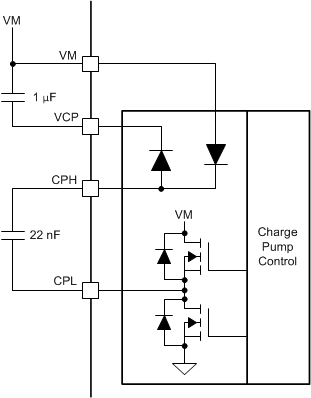SLVSE38A April 2018 – July 2018 DRV8306
PRODUCTION DATA.
- 1 Features
- 2 Applications
- 3 Description
- 4 Revision History
- 5 Pin Configuration and Functions
- 6 Specifications
-
7 Detailed Description
- 7.1 Overview
- 7.2 Functional Block Diagram
- 7.3
Feature Description
- 7.3.1 Three Phase Smart Gate Drivers
- 7.3.2 DVDD Linear Voltage Regulator
- 7.3.3 Pulse-by-Pulse Current Limit
- 7.3.4 Hall Comparators
- 7.3.5 FGOUT Signal
- 7.3.6 Pin Diagrams
- 7.3.7 Gate-Driver Protective Circuits
- 7.4 Device Functional Modes
- 8 Application and Implementation
- 9 Power Supply Recommendations
- 10Layout
- 11Device and Documentation Support
- 12Mechanical, Packaging, and Orderable Information
Package Options
Mechanical Data (Package|Pins)
- RSM|32
Thermal pad, mechanical data (Package|Pins)
- RSM|32
Orderable Information
7.3.1.3 Gate Driver Voltage Supplies
The high-side gate-drive voltage supply is created using a doubler charge pump that operates from the VM voltage supply input. The charge pump lets the gate driver correctly bias the high-side MOSFET gate with respect to its source across a wide input supply voltage range. The charge pump is regulated to maintain a fixed output voltage of VVM + 10 V and supports an average output current of 15 mA. When the VVM voltage is less than 12 V, the charge pump operates in full doubler mode and generates VVCP = 2 × VVM – 1.5 V when unloaded. The charge pump is continuously monitored for undervoltage to prevent under-driven MOSFET conditions. The charge pump requires a X5R or X7R, 1-µF, 16-V ceramic capacitor between the VM and VCP pins to act as the storage capacitor. Additionally, a X5R or X7R, 22-nF, VM-rated ceramic capacitor is required between the CPH and CPL pins to act as the flying capacitor.
 Figure 11. Charge Pump Architecture
Figure 11. Charge Pump Architecture The low-side gate drive voltage is created using a linear low-dropout (LDO) regulator that operates from the VM voltage supply input. The LDO regulator allows the gate driver to properly bias the low-side MOSFET gate with respect to ground. The LDO regulator output is fixed at 10 V and supports an output current of 15 mA. The LDO regulator is monitored for undervoltage to prevent under-driven MOSFET conditions.